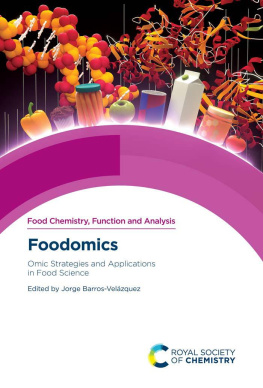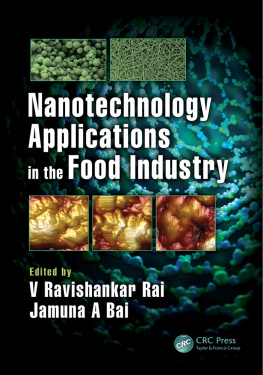Contents
G. lvarez-Rivera, A. Valds, C. Len and A. Cifuentes
A. Sandionigi and A. Bruno
V. Cunsolo, V. Muccilli, R. Saletti and S. Foti
Jennifer Janovick, Kathryn Williamson and Emmanuel Hatzakis
K. Bhme and P. Calo-Mata
P. Calo-Mata, Ana G. Abril, J. Barros Velzquez and T. G. Villa
S. Levorato and A. V. Nathanail
I. Ortea
Andrey Ipatov, Alejandro Garrido-Maestu, Joana Rafaela Guerreiro, Agnes Purwidyantri, Sarah Azinheiro, Joana Carvalho, Foteini Romani, Monisha Elumalai and Marta Prado
Sylvain Aubry, Sarai Reyes Avila, Daniel Croll and Bastien Christ
Monika Yadav, Ishu Khangwal, Guddu Kumar Gupta and Pratyoosh Shukla
D. Rodrigues, D. Almeida, A. M. Gomes and A. C. Freitas
Y. Fu and W. Wu
Mnica Carrera and Jos M. Gallardo
. Kurtanjek
D. Guggisberg, H. Joosten, P. Fuchsmann and G. Vergres
Rajveer Singh, Robin Joshi, Eduardo D. Munaiz, Sanjay Kumar and Arun Kumar
Zonghao Yue, Yatao Jiang and Zhongke Sun
Maurizio Mennini, Valeria Marzano, Lorenza Putignani and Alessandro Fiocchi
Foodomics
Omic Strategies and Applications in Food Science
Foodomics
Omic Strategies and Applications in Food Science
Edited by
Jorge Barros-Velzquez
University of Santiago de Compostela, Spain
Email:

Food Chemistry, Function and Analysis No. 26
Print ISBN: 978-1-78801-884-5
PDF ISBN: 978-1-83916-300-5
EPUB ISBN: 978-1-83916-301-2
Print ISSN: 2398-0656
Electronic ISSN: 2398-0664
A catalogue record for this book is available from the British Library
The Royal Society of Chemistry 2021
All rights reserved
Apart from fair dealing for the purposes of research for non-commercial purposes or for private study, criticism or review, as permitted under the Copyright, Designs and Patents Act 1988 and the Copyright and Related Rights Regulations 2003, this publication may not be reproduced, stored or transmitted, in any form or by any means, without the prior permission in writing of The Royal Society of Chemistry or the copyright owner, or in the case of reproduction in accordance with the terms of licences issued by the Copyright Licensing Agency in the UK, or in accordance with the terms of the licences issued by the appropriate Reproduction Rights Organization outside the UK. Enquiries concerning reproduction outside the terms stated here should be sent to The Royal Society of Chemistry at the address printed on this page.
Whilst this material has been produced with all due care, The Royal Society of Chemistry cannot be held responsible or liable for its accuracy and completeness, nor for any consequences arising from any errors or the use of the information contained in this publication. The publication of advertisements does not constitute any endorsement by The Royal Society of Chemistry or Authors of any products advertised. The views and opinions advanced by contributors do not necessarily reflect those of The Royal Society of Chemistry which shall not be liable for any resulting loss or damage arising as a result of reliance upon this material.
The Royal Society of Chemistry is a charity, registered in England and Wales, Number 207890, and a company incorporated in England by Royal Charter (Registered No. RC000524), registered office: Burlington House, Piccadilly, London W1J 0BA, UK, Telephone: +44 (0) 20 7437 8656.
Visit our website at www.rsc.org/books
Printed in the United Kingdom by CPI Group (UK) Ltd, Croydon, CR0 4YY, UK
Foodomics
Omic Strategies and Applications in Food Science
Food Chemistry, Function and Analysis
Series editors:
Gary Williamson, Monash University, Australia
Alejandro G. Marangoni, University of Guelph, Canada
Graham A. Bonwick, AgriFoodX Limited, UK
Catherine S. Birch, AgriFoodX Limited, UK
Titles in the series:
1: Food Biosensors
2: Sensing Techniques for Food Safety and Quality Control
3: Edible Oil Structuring: Concepts, Methods and Applications
4: Food Irradiation Technologies: Concepts, Applications and Outcomes
5: Non-extractable Polyphenols and Carotenoids: Importance in Human Nutrition and Health
6: Cereal Grain-based Functional Foods: Carbohydrate and Phytochemical Components
7: Steviol Glycosides: Cultivation, Processing, Analysis and Applications in Food
8: Legumes: Nutritional Quality, Processing and Potential Health Benefits
9: Tomato Chemistry, Industrial Processing and Product Development
10: Food Contact Materials Analysis: Mass Spectrometry Techniques
11: Vitamin E: Chemistry and Nutritional Benefits
12: Anthocyanins from Natural Sources: Exploiting Targeted Delivery for Improved Health
13: Carotenoid Esters in Foods: Physical, Chemical and Biological Properties
14: Eggs as Functional Foods and Nutraceuticals for Human Health
15: Rapid Antibody-based Technologies in Food Analysis
16: DNA Techniques to Verify Food Authenticity: Applications in Food Fraud
17: Advanced Gas Chromatography in Food Analysis
18: Handbook of Food Structure Development
19: Mitigating Contamination from Food Processing
20: Biogenic Amines in Food: Analysis, Occurrence and Toxicity
21: Nutrition and Cancer Prevention: From Molecular Mechanisms to Dietary Recommendations
22: Health Claims and Food Labelling
23: Nutraceuticals and Human Health: The Food-to-supplement Paradigm
24: Nutritional Signalling Pathway Activities in Obesity and Diabetes
25: The Chemistry and Bioactive Components of Turmeric
26: Foodomics: Omic Strategies and Applications in Food Science
How to obtain future titles on publication:
A standing order plan is available for this series. A standing order will bring delivery of each new volume immediately on publication.
For further information please contact:
Book Sales Department, Royal Society of Chemistry, Thomas Graham House, Science Park, Milton Road, Cambridge, CB4 0WF, UK
Telephone: +44 (0)1223 420066, Fax: +44 (0)1223 420247,
Email:
Visit our website at www.rsc.org/books
Preface
I am delighted to introduce the book Foodomics Omic Strategies and Applications in Food Science to the scientific community. The main motivation of editing this book on foodomics was to document the latest research on this cutting-edge technology and to provide a general overview and updated applications by the hands of renowned international experts in the field. The term Foodomics was proposed a decade ago by Prof. Cifuentes, one of the contributors to this book. This term was intended to compile in a single discipline all advanced molecular techniques used to achieve proper food analysis. Since then, this discipline has experienced amazing development for several reasons: (i) the tremendous technical advances in the equipments and methodologies involved; (ii) the emergence of new challenges in food analysis, mainly derived from novel threats to food safety, and (iii) the discovery of the role of food components in human health, which has resulted in the development of novel terms such as nutrigenomics or nutrimetabolomics. In this text we provide, to the best of our knowledge, the most up-to-date reference book on the most relevant applications of omics in food science. This would not have been possible without the active participation of a myriad of relevant scientists from three continents that have generously shared their knowledge through specific and exhaustive chapters.







